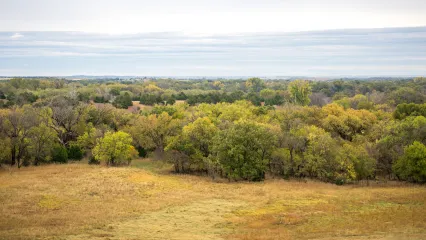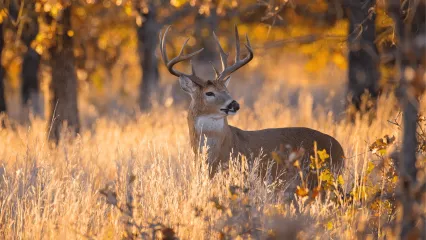
Contacts
Ft. Cobb WMA covers 3,500 acres in Caddo County around the north end of Ft. Cobb lake. Located south of Hwy 152 and east of Hwy 146, the area is a mixture of post oak, blackjack, red cedars and native mixed grasses. The area has uplands, flood plain and creek bottoms. Mixed grasses, plum thickets and eastern red cedar predominate on upland sites. The lake is fed by three tributaries, Willow Creek to the northeast, Lake Creek to the north and Cobb Creek to the west. All of these creeks are timbered with cottonwood, willow and some hardwoods. The annual precipitation for the area is about 28 inches.
From Binger: 12 miles west on State Hwy 152, 3½ miles south on N2490
- Quail: Bobwhite quail are present, but not abundant.
- Turkey: are present but not abundant.
- Deer: White-tailed deer are present throughout the area.
- Rabbit: Primarily cottontails, although a few jackrabbits may be present.
- Furbearers: Coyote, bobcat and raccoons are available.
- Dove: Dove are fairly common, but not abundant.
- Waterfowl: Ducks and geese are usually present in good numbers.
- Crows: Crows are present in fair numbers.
- Bald Eagle: Found in winter on the state park portion of the lake. They commonly use islands and points on the lake.
- Pelicans: Large numbers use the entire lake.
Approximately 22 wildlife feeding areas are planted annually. Red cedar control is used to improve tallgrass prairie habitat. The area has a 29 acre wetland development unit which relies on flood water to inundate. The wetland area is vegetated with native wetland plants.
Camping areas and three improved boat ramps are located on the WMA. Camp sites with hookups are available at the Ft. Cobb State Park (405-643-2249).
Bass, Saugeye, Crappie, Catfish and Hybrid Stripers are found in Ft. Cobb lake.
Unless otherwise provided, all hunting is restricted to archery, muzzleloader, and shotgun only..
All shotgun hunting is restricted to federally approved nontoxic shot on the Walnut Slough WDU portion.
Closed Seasons
Same As Statewide Seasons
Seasons w/ Special Restrictions
- Deer Gun
Open during the first nine days only. Restricted to muzzleloader and shotgun with slug.
- Youth Deer Gun
Restricted to muzzleloader and shotgun with slug.
- Holiday Antlerless Deer Gun
Restricted to muzzleloader and shotgun with slug.
- Snipe, Woodcock, Rabbit, Squirrel, Pursuit with Hounds for Furbearers, Predator/Furbearer Calling
Closed during the first nine days of deer gun season.
- Waterfowl
Hunting hours for waterfowl close at 1 p.m. daily on the WDU portion.
- Trapping
Open to water sets, live box traps and enclosed trigger traps only through Jan 31. Open same as statewide Feb 1 through end of February.
- Turkey Spring, Youth Turkey Spring
One-tom limit; seasons combined. Hunting hours close at 7:00 p.m. daily.
- Quail
Closed during the first nine days of deer gun season. Closed to non-resident hunting February 1-15.
Hunter and angler camping is allowed in designated areas.
Anadarko Visitor’s Center
Highway 62 East
Anadarko, OK 73005
405-247-5555
1-800-433-5661
Great Plains Country
114 South 9th St, Suite A Frederick OK 73542
580-335-5999
gpc@greatplainscountry.com
www.greatplainscountry.com
Oklahoma Tourism and Recreation Department
Post Office Box 52002
Oklahoma City, OK 73152-2002
(800) 652-6552 or (405) 521-2409
www.travelok.com
Weatherford Chamber of Commerce
580-772-7744
www.weatherfordchamber.com
Controlled Hunts: Yet More Ways to Up Your Odds
Additional features continue to be added to the Wildlife Department’s controlled hunts program.
Cackling Geese Tracked in Central Flyway Study
Researchers are tracking cackling geese wintering in a five-state study area to learn more about their movements and habitat preferences.
Study Focused on Bats and Disease-causing Fungus
Bat surveys were conducted to learn more about Oklahoma’s bat communities and hundreds of bats were swabbed for the fungus that causes white-nose syndrome.


